Pulse Laser Cleaning Machine and Continuous Laser Cleaner
Application Description
In the field of laser cleaning, fiber lasers have become the best choice of light source for laser cleaning with higher reliability,
stability and flexibility.
As the two major components of fiber lasers, continuous fiber lasers and pulsed fiber lasers are firmly occupying the leading positions
in the market for macroscopic material processing and precision material processing respectively.
For emerging laser cleaning applications, there are different voices on whether continuous or pulsed lasers should be used,
and two types of laser cleaning equipment using both pulsed and continuous lasers have appeared on the market,
with many industrial end-users unsure of how to choose when making their selection.
This article provides a comparative test of continuous and pulsed lasers for laser cleaning applications,
and analyzes their respective characteristics and applicable application scenarios.
I. Test materials
1、Laser
The laser model YDFLP-CL-200-12-A is a pulsed laser and CW-R-B-W-2000 is a continuous laser.
The detailed parameters of the two lasers are compared as shown in Table 1
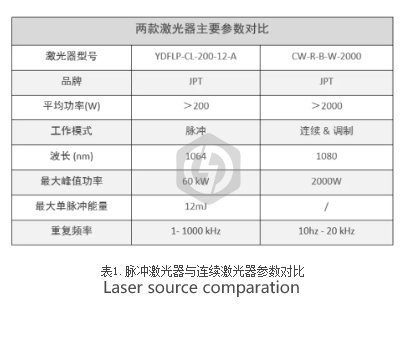
2、Materials
The sample 1 used in the experiment is an aluminum alloy flat plate, the dimensions of the aluminum alloy flat plate are 400 mm×400 mm×4 mm,
and the sample 2 is a carbon steel flat plate,
and the dimensions of the carbon steel are 400 mm×400 mm×10 mm.
The surface of the samples is sprayed with white paint, and the thickness of the paint on the surface of the sample 1 is about 20 μm,
and the thickness of the paint on the surface of the sample 2 is about 40 μm.
II. Test results
Two kinds of lasers were used to carry out paint removal experiments on two kinds of material surfaces,
to optimize the laser cleaning parameters,
to obtain the best pulse width, frequency, scanning speed and other parameters,
and to compare the cleaning effect and efficiency under the optimized experimental conditions.
1、Pulse laser cleaning paint layer experiment
In the pulsed light paint removal experiments in the laser power of 200 W, the use of the field mirror focal length of 163 mm,
the laser focus spot diameter of about 0.32 mm, cleaning a single area range of 13 mmx13 mm, fill spacing of 0.16 mm,
aluminum alloy surface paint removal laser scanning and cleaning 2 times,
carbon steel surface paint removal laser scanning and cleaning 4 times.
In order to ensure that the longitudinal and transverse superposition rate of the spot are 50% of the conditions,
test the laser pulse width, frequency and laser scanning speed of the parameters (shown in Table 2) on the cleaning effect,
aluminum alloy surface paint removal experimental results as shown in Figure 1,
carbon steel surface paint removal experimental results as shown in Figure 2.
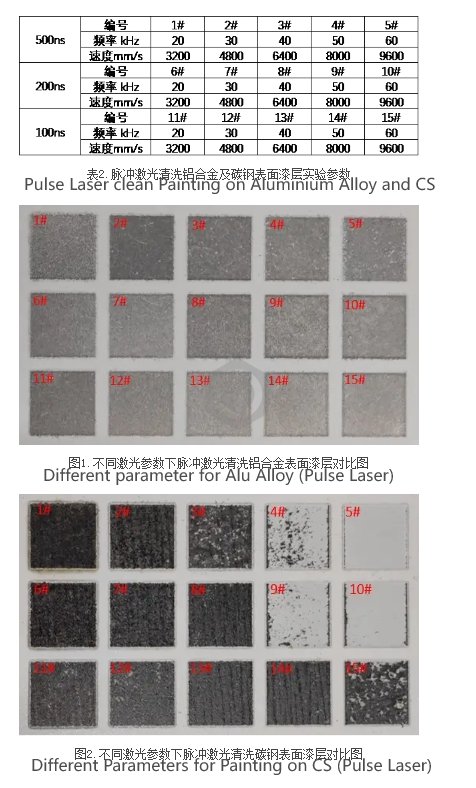
and carbon steel surface paint layer clean,
in the same pulse width, the lower the frequency is more likely to cause damage to the substrate, when the frequency is greater than a certain value,
the higher the frequency of the paint layer removal effect will be worse.
Experimental results of pulsed laser cleaning aluminum alloy surface paint layer of the preferred parameters for 15 #
(laser power 200 W, pulse width 100 ns, frequency 60 kHz, scanning speed 9600 mm / s),
cleaning carbon steel surface paint layer of the preferred parameters for 13 # (laser power 200 W, pulse width 100 ns, frequency 40 kHz,
scanning speed of 6400 mm / s),
the parameters of the two will be Both parameters remove the paint layer cleanly, and there is basically no damage to the sample substrate.
2. Experiments on Continuous Laser Cleaning of Paint Layers
In the continuous light paint removal experiments, the use of laser power of 50%,
duty cycle of 20% (equivalent to an average power of 200 W),
the frequency of 30 kHz, the use of the field mirror focal length of 220 mm,
the laser focusing spot diameter of about 0.2 mm, cleaning a single area range of 13 mmx13 mm,
fill spacing of 0.1 mm, the cleaning of the aluminum alloy surface layer of paint, the laser repeated scanning 2 times,
the cleaning of carbon steel surface layer of paint, the laser repeated scanning 2 times, the cleaning of the surface layer of paint.
When cleaning the aluminum alloy surface paint layer, the laser repeated scanning 2 times, and when cleaning the carbon steel surface paint layer,
the laser repeated scanning 4 times. Under the conditions of constant laser power, duty cycle and frequency,
the effect of laser scanning speed on the cleaning effect was tested.
The cleaning parameters for aluminum alloy surface paint removal are shown in Table 3,
and the cleaning effect is shown in Figure 3. The cleaning parameters of carbon steel surface paint removal are shown in Table 4,
and the cleaning effect is shown in Figure 4.
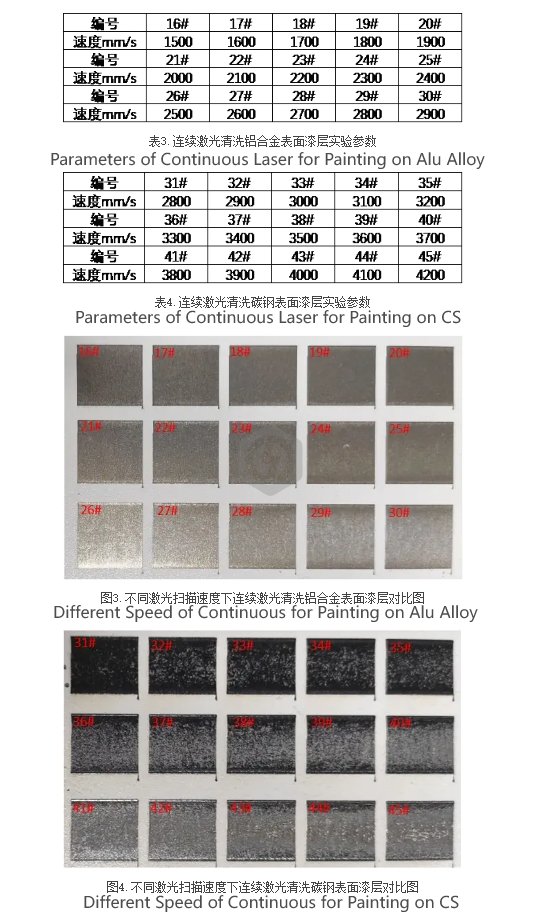
the greater the damage caused to the substrate.
When the scanning speed is greater than a certain value, the faster the scanning speed, the worse the paint removal effect.
Experimental results of continuous laser cleaning aluminum alloy surface paint layer
preferred parameters for 21 # (laser power 200 W, frequency 30 kHz, scanning speed 2000 mm / s),
cleaning carbon steel surface paint layer preferred parameters for 37 # (laser power 200 W, frequency 30 kHz, scanning speed 3400 mm / s).
These two parameters will not only remove the carbon steel surface paint layer cleanly,
and the damage caused to the sample substrate is relatively small.
Third, the results of the preferred parameters and analysis
1. Comparison of macro-cleaning condition
The results of the preferred parameters for pulsed light cleaning of aluminum alloy surface paint layer are shown in Figure 5a,
and the results of the preferred parameters for continuous light cleaning of aluminum alloy surface paint layer are shown in Figure 5b.
After pulsed light cleaning, the paint layer on the surface of the sample was completely removed, and the surface of the sample showed
metallic white color,
and there was almost no damage to the substrate of the sample. After continuous light cleaning, the paint layer on the sample surface was
also completely removed,
but the surface of the sample appeared grayish black and the substrate of the sample was slightly melted. Therefore,
the use of continuous light is more likely to cause damage to the substrate than pulsed light.
The results of the preferred parameters for cleaning the carbon steel surface paint layer with pulsed light are shown in Fig. 5c,
and the results of the preferred parameters for cleaning the carbon steel surface paint layer with continuous light are shown in Fig. 5d.
After cleaning with pulsed light, the lacquer layer on the surface of the sample was completely removed,
and the surface of the sample showed a gray-black color,
and the damage to the sample substrate was small. After continuous light cleaning,
the paint layer on the surface of the sample is also completely removed,
but the surface of the sample shows a deep black color,
which can be visualized as a large remelting phenomenon on the surface of the sample. Therefore,
the use of continuous light is more likely to cause damage to the substrate than pulsed light.
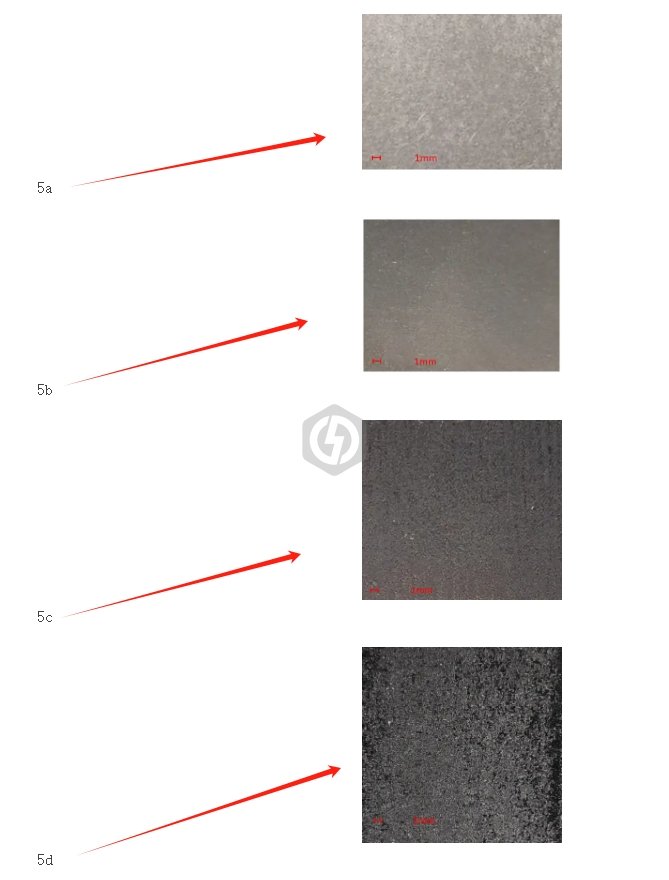
2. Microscope microscopic morphology comparison
From Fig. 6(a), it can be seen that after using pulsed light to clean the paint layer on the surface of the aluminum alloy,
the paint on the surface of the sample has been completely removed,
and there is little damage on the surface of the sample without laser lines.
In contrast, when continuous light was used to clean the sample, as shown in Fig. 6(b), the paint was also completely removed,
but the surface of the sample showed serious remelting phenomenon, and laser lines also appeared.
From Figure 6 (c) can be seen after the use of pulsed light cleaning carbon steel surface paint layer,
the sample surface paint has been completely removed,
and the sample surface damage is small after cleaning the surface is relatively flat.
While the use of continuous light cleaning sample surface as shown in Figure 6 (d) paint is also completely removed,
but the sample surface appears more serious remelting phenomenon, and the sample surface is uneven.
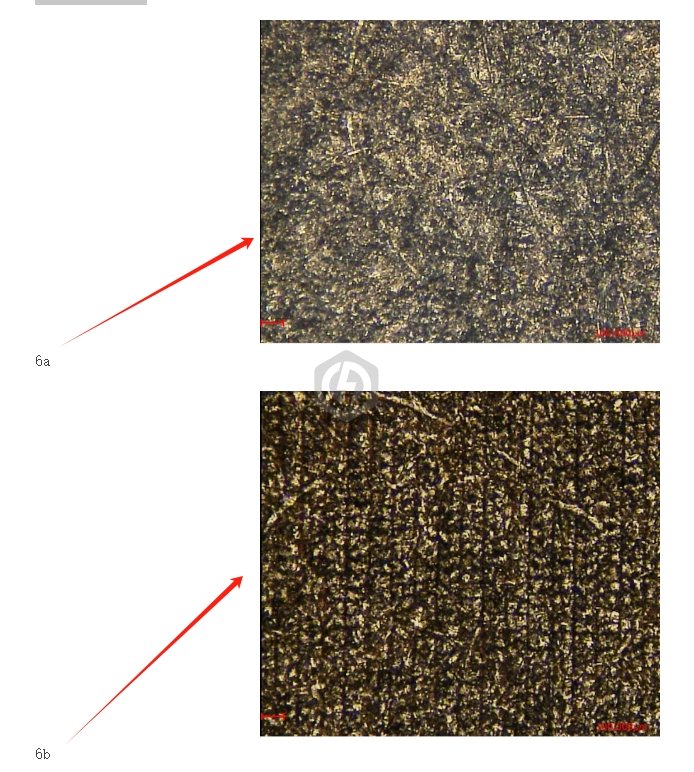
Figure 6. Comparison of the surface micro-morphology of the sample after the removal of paint by pulsed light and continuous light.
3. Comparison of material surface roughness
Figure 7 shows the comparison of surface roughness condition after laser paint removal. From Fig. 7,
it can be seen that after the laser cleaning of aluminum alloy surface paint layer,
pulsed light on the sample surface damage is small, so the surface roughness of the sample after cleaning is close to the original material.
The damage to the surface of the sample after continuous light cleaning is larger,
which results in the surface roughness of the cleaned sample being 1.5 times the roughness value of
the original material and 1.7 times the surface roughness after pulsed light cleaning.
Laser cleaning of carbon steel surface paint layer, pulsed light on the sample surface damage is smaller,
so after cleaning the sample surface roughness and the original material is close to or even lower than the raw material.
After the use of continuous light cleaning, the damage to the surface of the sample is larger,
which leads to the surface roughness of the sample after cleaning for the original material roughness value of 1.5 times,
for the pulsed light cleaning after the surface roughness of 1.7 times.
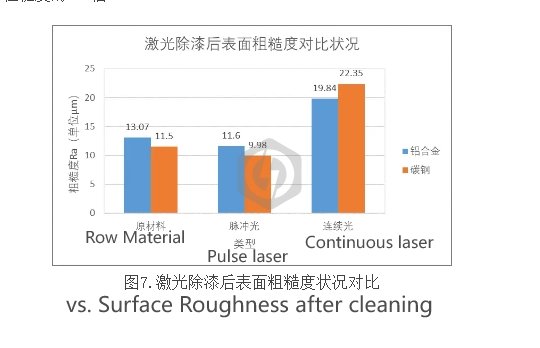
4.Comparison of cleaning efficiency
In terms of aluminum alloy surface paint removal, the paint removal efficiency of pulsed light is much higher than that of continuous light,
which is 7.7 times higher than that of continuous light. The cleaning efficiency of pulsed light is 2.77m²/h,
while the cleaning efficiency of continuous light is 0.36m²/h.
In the case of carbon steel surface paint removal, the removal efficiency with pulsed light was also higher than that with continuous light,
at 3.5 times the efficiency of continuous light. The cleaning efficiency with pulsed light was 1.06m²/h compared to 0.3m²/h with continuous light.
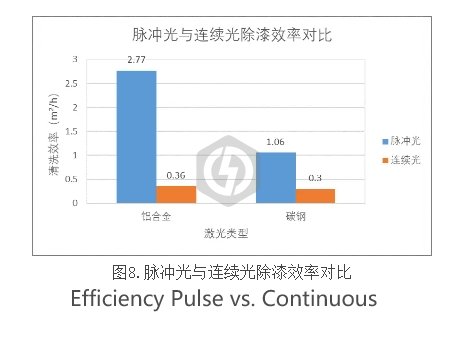
The test shows that both continuous laser and pulsed laser can remove the paint on the surface of the material to achieve the effect of cleaning.
Under the condition of the same power, the efficiency of the pulsed laser cleaning is much higher than that of the continuous laser,
at the same time,
the pulsed laser can better control the heat input and prevent the substrate from overheating or producing microfusion.
Continuous lasers have the advantage of price, you can use high-power lasers to make up for the efficiency gap with pulsed lasers,
but the heat input of high-power continuous light is greater, and the degree of damage to the substrate will also increase.
Therefore, there is a fundamental difference between the two in the application scenarios.
High precision, the need for strict control of substrate heating, the requirement of substrate damage-free application scenarios,
such as molds, should choose a pulsed laser. For some large steel structures, pipelines, etc., due to the large volume of heat dissipation,
the substrate damage requirements are not high, you can choose a continuous laser.
Application Info
- By BOGONG MACHINERY
- Date Aug 08, 2024
- In Laser Cleaning Machine
Waste no more time
Don't hesitate to tell us your needs
